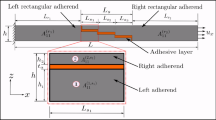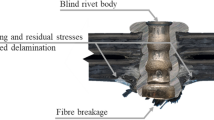Abstract
Rotary braiding is a cost effective method to manufacture near net shaped preforms that generally have a closed section and may have an arbitrary shape if braiding is performed over a shaped mandrel. The reinforcement architecture can be varied by the number and spacing of active bobbins, and by the speeds used to ‘take-up’ the braid and move the circumferential bobbins. Analytical methods are available that can reliably predict yarn paths and the final braid meso-structure for simple regular sections, and further analytical methods have been proposed to estimate composite braid elastic mechanical properties. A full simulation chain using the explicit Finite Element (FE) technique is presented for composite braid manufacture and mechanical stiffness prediction of the final composite. First simulation of the braiding process provides detailed information on yarns paths and braid meso-structure, from which Representative Volume Elements (RVE) of the braid may be constructed for analysis of stiffness properties. The techniques are general and can be applied to any braid geometry. A specific problem of meshing the yarn structure and interspersed resin volumes is overcome using conventional solid elements for the yarns and Smooth Particle Hydrodynamics for the resin, with link element to join the two constituents. Details of the background theory, braid simulation methods, meso- model analysis and validation again analytical and test measurements are presented.






















Similar content being viewed by others
References
Chen, L., et al.: Mechanical analysis of 3-D braided composites by the finite multiphase element method. Compos. Sci. Technol. 59, 2383–2391 (1999)
Ayranci, C., Carey, J.: 2D braided composites: a review for stiffness critical applications. Compos. Struct. 85, 43–58 (2008)
Visual-Crash for PAM™, Version 4.5, ESI Group (2008)
Zeng, T., et al.: Mechanical analysis of 3D braided composites: a finite element model. Compos. Struct. 64, 399–404 (2004)
WiseTex, Department MTM, Katholieke Universiteit Leuven (2000–2006)
TexComp, Department of Metalurgy and Materials Engineering, Katholieke Universiteit Leuven (2004)
Cox, B.N., Flanagan, G.: Handbook of analytical methods for textile composites. NASA (1997)
Cook, R.D., Malkus, D.S., Plesha, M.E.: Concepts and applications of Finite Element analysis. Wiley Publ. (1989)
Morris, J.P.: An Overview of the Method of Smoothed Particle hydrodynamics. Universität Kaiserslautern (1995)
Virtual performance solutions: Explicit solver notes manual (released Feb-08), ESI Group (2008)
Vingjevic, R.: Review of Development of Smooth Particle Hydrodynamics (SPH) Method, Crashworthiness, Impact and Structural Mechanics, CISM9. Cranfield University, UK
Virtual performance solutions: Explicit and implicit solver reference manual, ESI Group (2008)
PAM-CRASHTM: ESI Software Engineering Systems International, 99 rue des Solets, SILIC 112, 94513 Rungis Cedex, France (2006)
Erber, A., Birkefeld, K., Drechsler, K.: The influence of braiding configuration on damage tolerance of drive shafts, SAMPE Europe (2009)
Greve, L., Pickett, A.K.: Delamination testing and modelling for composite crash simulation. Compos. Sci. Technol. 66, 816–826 (2006)
Acknowledgements
The authors would like to thank the CEC Marie Curie training scheme (project MOMENTUM) and Liebherr-Aerospace Lindenberg GmbH in the public funded project (LuFo IV program) for their financial support.
Author information
Authors and Affiliations
Corresponding author
Rights and permissions
About this article
Cite this article
Pickett, A.K., Sirtautas, J. & Erber, A. Braiding Simulation and Prediction of Mechanical Properties. Appl Compos Mater 16, 345–364 (2009). https://doi.org/10.1007/s10443-009-9102-x
Received:
Accepted:
Published:
Issue Date:
DOI: https://doi.org/10.1007/s10443-009-9102-x




